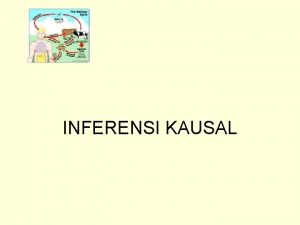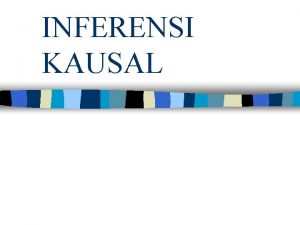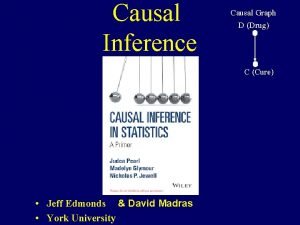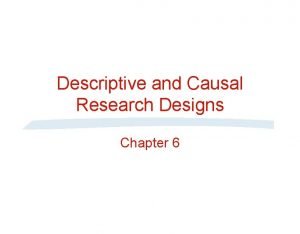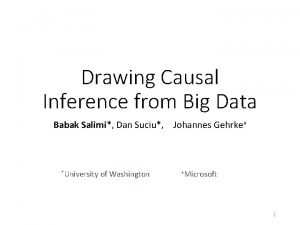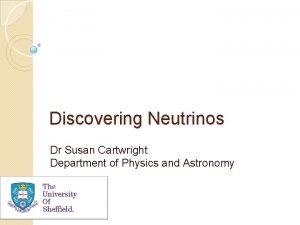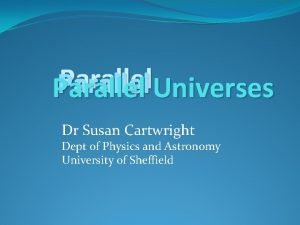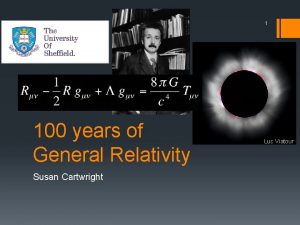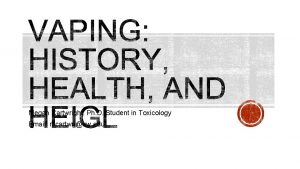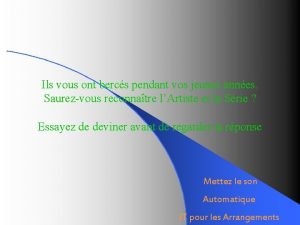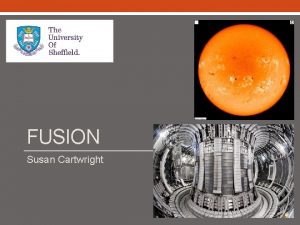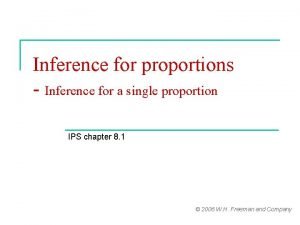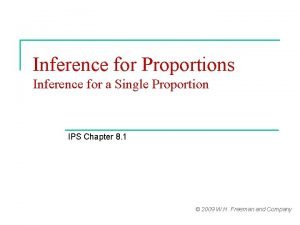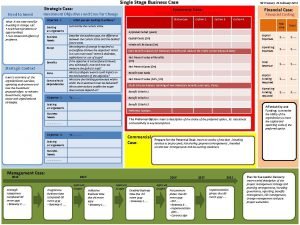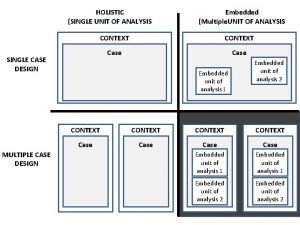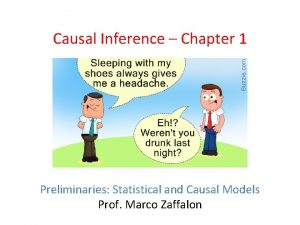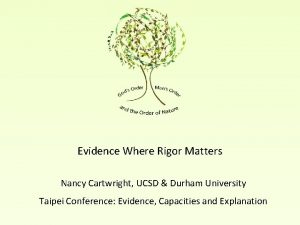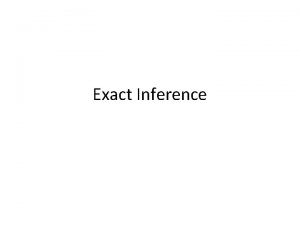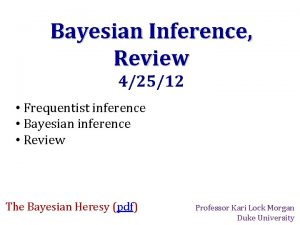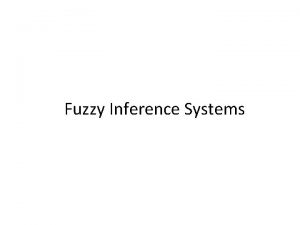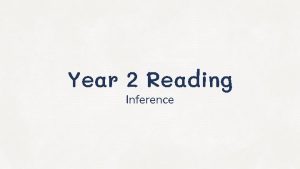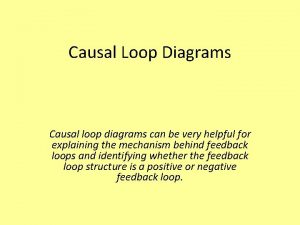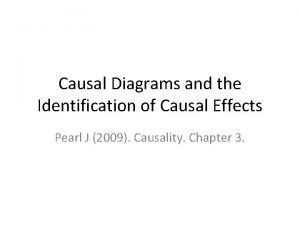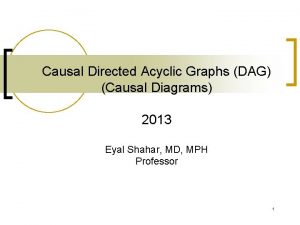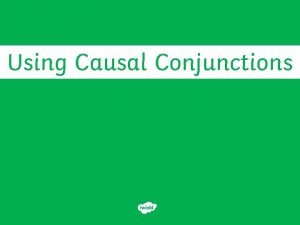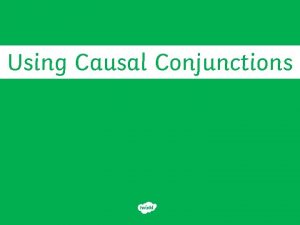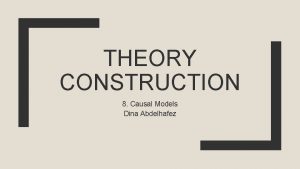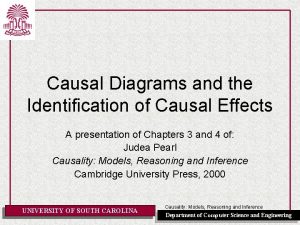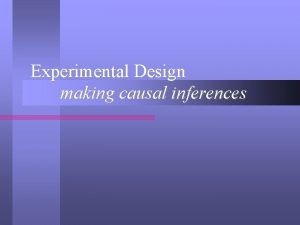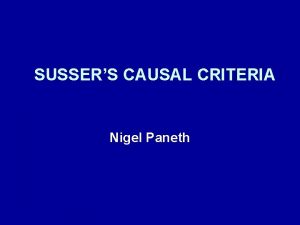Causal inference Evidencing the single case Nancy Cartwright












































- Slides: 44

Causal inference: Evidencing the single case Nancy Cartwright, Durham & UCSD ESRC Methods Festival, 2018

�Can we have good evidence for causation in the single case? Yes �Do we need to establish a counterfactual to do so? No

Categories of Evidence for “C caused E in i” Evidence for single case Direct Cause characteristics Effect characteristics Indirect Presence of moderators Operation of mediators Direct Cause characteristics Effect characteristics Causal potential Elimination of alternatives Symptoms of operation Absence of derailers Indirect Presence of moderators Presence of mediators Causal potential Elimination of alternatives Symptoms of operation Absence of drailers 3

�These are familiar, ‘tried and true’ ◦ Legal proceedings ◦ Daily life ◦ Case studies and causal process tracing ◦… �Nevertheless, we are told…. �They can’t do the job Why?

�Sceptics, esp RCT advocates, say you must establish a counterfactual to establish a singular causal claim The need to ‘compare like with like’ in fair tests of treatments has been recognised by some people for a long time. (Sir Iain Chalmers)

�Sceptics, esp RCT advocates, say you must establish a counterfactual to establish a singular causal claim Nothing can be learned about the causes of the dependent variable without taking into account other instances when the independent variable takes on other values. (King, Keohane & Verba, 1994)

�Sceptics, esp RCT advocates, say you must establish a counterfactual to establish a singular causal claim �They claim: You just can’t do that �So I aim, to the contrary To show that these non-counterfactual evidence types are evidence for a singular causal claim �Using the same device that shows that RCTs can establish causal claims �Potential outcomes equations SCEMs

�Part 1: Evidence Types �Part 2: Explain POEs �Part 3. Generalise these to SCEMs �Part 4: Show these evidence types fill in the SCEM from which the claim drives �Before that…

Why bother? �Post hoc evaluation �Many of these evidence types double for ex ante prediction �Singular causal claims probe/corroborate general causal claims Oops! We know we can’t generalise from a single case

Yes, but… �We can’t generalise from 10 or 1000 or even 40, 000 cases �There are >2000 swans in the Thames �All white �In the right season, > 40, 000 in the UK �All white �Still in Sidney Harbour…

Yes, but… �We can’t generalise from 10 or 1000 or even 40, 000 cases �There are >2000 swans in the Thames �All white �At the right time of year, > 40, 000 in the UK �All white �Still in Sidney Harbour…

Generalisability �Depends on Projectability �Not sample size

�Gravity Probe B measured the geodetic- and frame-dragging effects of space-time curvature near the Earth (to test Einstein's General Theory of Relativity)

�Gravity Probe B measured the geodetic- and frame-dragging effects of space-time curvature near the Earth (to test Einstein's General theory of relativity) �And drew conclusions from … 3 gyroscopes

Moreover: the much vaunted RCTs… �Can only provide evidence that the treatment caused the effect for ◦ Some individuals ◦ Somewhere in the study population �So, they establish ◦ Singular causal claims ◦ We just don’t know for whom �That’s why I call them…

RCTs = ‘Where’s Wally? ’ Studies

Part 1 Categories of Evidence for “C caused E in i” Evidence for single case Direct Cause characteristics Effect characteristics Indirect Presence of moderators Operation of mediators Direct Cause characteristics Effect characteristics Causal potential Elimination of alternatives Symptoms of operation Absence of derailers Indirect Presence of moderators Presence of mediators Causal potential Elimination of alternatives Symptoms of operation Absence of drailers

Part 1 Evidence for ‘C caused E in i’ • Direct: Evidence looking at aspects of the putative causal relationship to see if it holds • Indirect: Evidence looking at features outside the putative causal relationship that bear on its existence 18

Part 1 5 kinds of direct evidence 1. Congruence 2. 3. 4. 5. The character of the cause: did C occur at the time, in the manner & of the size to be expected had it caused E? The character of the effect: does E occur at the time, in the manner & of the size to be expected had C caused it? Presence of support factors (moderator variables): was everything in place needed for C to produce E? Presence of intermediate steps (mediator variables): were the right kinds of intermediate stages present? Operation of intermediaries: were mediators really caused by C and did they really cause E? 19

Part 1 4 kinds of indirect evidence Causal potency: is C able to produce E in i? 2. Elimination of alternatives: what else could have produced E in i & what evidence is there against them? 3. Symptoms that the cause operated: what operated further features should hold if the cause had acted as needed? 4. Absence of derailers: were there features that could stop C from resulting in E? 1. 20

Part 2 Towards POEs: Epidemiologists’ pies S Rothman KJ. Causes. Am J Epidemiol 1976; 104: 587– 592

Part 2 JL Mackie � c 1974 c

Potential outcomes equation Part 2 y(i) c= β(i)x(i) + w(i) �x(i) is the focal cause of y for individual i (the ‘treatment’) �w(i): contribution to y for i of all other causal ‘pies’ �β(i): net effect of the α-weighted support factors – the rest of x’s pie (interactive/moderator variables)

Part 2 What Justifies that RCTs estimate treatment effects ? ? y(i) c= β(i)x(i) + w(i) �Suppose orthogonality in study pop’n: Exp(w/x) = Exp(w); Exp(β/x) = Exp(β) �Then, it’s provable that Exp(Y/x=1) – Exp(Y/x=0 ) = Exp(β) �The difference in observed mean outcomes is an unbiased estimate of the study pop’n ATE

Part 3 SCEMs: Structural Causal Equations Models x 1(i) x 2(i) c= α 21(i)a 21(i) x 3(i) c= α 31(i)a 31(i) x 1(i) + α 32(i)a 32(i) x 2(i) … 25

Part 3 � � � � The SCEM supposes a time slicing Variables are time-ordered Each equation gives direct causes relative to the time slicing Our outcome E could be anywhere – say x 5 Our cause of interest C could be too – say x 2 The SCEM is richer than the single POE. It represents causes of causes and further effects Which can be very informative!!

Part 3 ‘…the existence of official minutes of a meeting, � The SCEM supposes a time slicing if authentic, provides strong proof that a � Variables are time-ordered meeting took place. ’ � Each equation gives direct causes relative to the (Beach & Pedersen, Process-Tracing Methods, 2013) time slicing � Our outcome E could be anywhere – say x 5 � Our cause of interest C could be too – say x 2 � The SCEM is richer than the POE. It represents causes of causes and further effects � Which can be very informative!!

Categories of Evidence for “C caused E in i” Part 4 Evidence for single case Direct Cause characteristics Effect characteristics Indirect Presence of moderators Operation of mediators Direct Cause characteristics Effect characteristics Causal potential Elimination of alternatives Symptoms of operation Absence of derailers Indirect Presence of moderators Presence of mediators Causal potential Elimination of alternatives Symptoms of operation Absence of drailers 28

Part 4 Justifying these as evidence The point of the SCEM is… Each of these types of evidence helps establish something about a feature in the SCEM relevant to the existence of a causal pathway from C to E

Categories of Evidence for “C caused E in i” Evidence for single case Direct Cause characteristics Effect characteristics Indirect Presence of moderators Operation of mediators Direct Cause characteristics Effect characteristics Causal potential Elimination of alternatives Symptoms of operation Absence of derailers Indirect Presence of moderators Presence of mediators Causal potential Elimination of alternatives Symptoms of operation Absence of drailers 30

Cause & effect characteristics x 2 = a 21 x 1 x 3 = a 31 x 1 + a 32 x 2 x 4 = a 41 x 1 + a 42 x 2 + a 43 x 3 xn = an 1 x 1 + an 2 x 2 + … + ann-1 xn-1 See size relations � Time: from time slicing & indexing of xs � 31

Categories of Individualized Evidence for “C caused E in i” Evidence for single case Direct Cause characteristics Effect characteristics Indirect Presence of moderators Operation of mediators Direct Cause characteristics Effect characteristics Causal potential Elimination of alternatives Symptoms of operation Absence of derailers Indirect Presence of moderators Presence of mediators Causal potential Elimination of alternatives Symptoms of operation Absence of drailers 32

Intermediaries x 2 = a 21 x 1 x 3 = a 31 x 1 + a 32 x 2 x 4 = a 41 x 1 + a 42 x 2 + a 43 x 3 xn = an 1 x 1 + an 2 x 2 + … + ann-1 xn-1 33

Categories of Individualized Evidence for “C caused E in i” Evidence for single case Direct Cause characteristics Effect characteristics Indirect Presence of moderators Presence of mediators Operation of mediators Direct Cause characteristics Effect characteristics Causal potential Elimination of alternatives Symptoms of operation Absence of derailers Indirect Presence of moderators Presence of mediators Causal potential Elimination of alternatives Symptoms of operation Absence of drailers 34

Elimination of alternatives x 2 = a 21 x 1 x 3 = a 31 x 1 + a 32 x 2 x 4 = a 41 x 1 + a 42 x 2 + a 43 x 3 xn = an 1 x 1 + an 2 x 2 + … + ann-1 xn-1 � Do these Add up to this? 35

So… �SCEMs play a vital role in evidencing singular causal claims �They provide the framework for principled derivation that ◦ RCTs do what’s claimed for them in evidencing causal claims ◦ Features from our catalogue evidence singular causal connections

Pro SCEMs: SCEMs provide �A rigorous justification ◦ That our evidence types are evidence for singular causal claims ◦ And how �A way of systematising & synthesising the evidence �And of assessing its strength – �Because we can make explicit and so can see ◦ What is assumed ◦ What role each piece of evidence plays ◦ What’s missing

Anti SCEMs (? ) �No formulas for estimating probability of truth �They are (too) model heavy With an RCT, we do inference by study design nwithout modelling assumptions A “research design” is a characterization of the logic that connects the data to the causal inferences the researcher asserts they support. It is essentially an argument as to why someone ought to believe the results. …In the case of a randomized controlled trial… there is little room for doubt about the causal effects of treatment so there’s hardly any argument necessary. [Austin Frak, The Incidental Economist] You can build a SCEM to do it properly �No we don’t �Things happen post-randomisation �You can handle that casually & piecemeal �Or…

Conclusions �We can have pprincipled evidence for singular causation �Of just the kind soc sci produces �Lots of it �And without establishing a counterfactual

Definitely not stuck with ‘Where’s Wally? ’ Studies

We can look at each Wally individually

Thank you • The K 4 U project has received funding from the European Research Council (ERC) under the European Union’s Horizon 2020 research and innovation programme (grant agreement No 667526 K 4 U) The above content reflects only the author's view and that the ERC is not responsible for any use that may be made of the information it contains. • This talk was also supported by a grant from the Spencer Foundation.

Philosophic aside Look what’s assumed y(i) c= β(i)x(i) + w(i) �Causal possibility ◦ There is a fixed set of factors that can contribute to y for i ◦ Which ones do so depends on the values that the variables – as, xs – actually take for i �For RCTs: the causal possibilities are the same for each member of the study pop’n

Philosophic aside Two attitudes re counterfactuals 1. The principles represented in the POEs are basic, the counterfactuals follow from them 2. The counterfactuals are basic, the equations are summaries of them.
 Causal inference ai
Causal inference ai Causal inference techniques
Causal inference techniques Causal inference vs correlation
Causal inference vs correlation Descriptive and causal inference
Descriptive and causal inference Causal inference
Causal inference Best worst and average case
Best worst and average case Susan cartwright sheffield
Susan cartwright sheffield Dr susan cartwright
Dr susan cartwright Dr susan cartwright
Dr susan cartwright Susan cartwright sheffield
Susan cartwright sheffield Julian cartwright
Julian cartwright Megan cartwright
Megan cartwright Joe cartwright
Joe cartwright Susan cartwright sheffield
Susan cartwright sheffield Inference for a single proportion
Inference for a single proportion Inference for a single proportion
Inference for a single proportion Single instruction stream
Single instruction stream Dataxin
Dataxin Single channel single phase example
Single channel single phase example Object diagram captures the behavior of a single use case
Object diagram captures the behavior of a single use case Single stage business case
Single stage business case Unit of analysis
Unit of analysis Hát kết hợp bộ gõ cơ thể
Hát kết hợp bộ gõ cơ thể Ng-html
Ng-html Bổ thể
Bổ thể Tỉ lệ cơ thể trẻ em
Tỉ lệ cơ thể trẻ em Voi kéo gỗ như thế nào
Voi kéo gỗ như thế nào Tư thế worm breton là gì
Tư thế worm breton là gì Chúa yêu trần thế
Chúa yêu trần thế Môn thể thao bắt đầu bằng từ đua
Môn thể thao bắt đầu bằng từ đua Thế nào là hệ số cao nhất
Thế nào là hệ số cao nhất Các châu lục và đại dương trên thế giới
Các châu lục và đại dương trên thế giới Công của trọng lực
Công của trọng lực Trời xanh đây là của chúng ta thể thơ
Trời xanh đây là của chúng ta thể thơ Cách giải mật thư tọa độ
Cách giải mật thư tọa độ Phép trừ bù
Phép trừ bù độ dài liên kết
độ dài liên kết Các châu lục và đại dương trên thế giới
Các châu lục và đại dương trên thế giới Thể thơ truyền thống
Thể thơ truyền thống Quá trình desamine hóa có thể tạo ra
Quá trình desamine hóa có thể tạo ra Một số thể thơ truyền thống
Một số thể thơ truyền thống Cái miệng nó xinh thế chỉ nói điều hay thôi
Cái miệng nó xinh thế chỉ nói điều hay thôi Vẽ hình chiếu vuông góc của vật thể sau
Vẽ hình chiếu vuông góc của vật thể sau Nguyên nhân của sự mỏi cơ sinh 8
Nguyên nhân của sự mỏi cơ sinh 8 đặc điểm cơ thể của người tối cổ
đặc điểm cơ thể của người tối cổ
